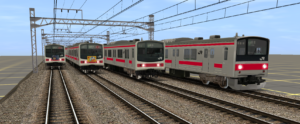
(left three: 1990s-built trains, right one: former Yamanote Line cars)
This is a reskin of the Nambu Line 205 Series by Rizky_Adiputra.
All the necessary dependencies are included in this package, avaible on the DLS or from Rizky’s website
Reskinned with permission.
DOWNLOAD
Originally planned as a freight-only line to complement the Musashino and Nambu Lines, the Keiyo Line opened it’s first section in 1975. Passenger services eventually began in 1986 using 103 Series trains transferred from the Keihin-Tohoku Line, and in 1988 the line was extended at both ends, now connecting Soga in Chiba Prefecture to Shin-Kiba on the outskirts of Tokyo.
In 1990 the last section of the line was inaugurated: the mostly underground link between Shin-Kiba and Tokyo station, and full Keiyo Line services began. To increase capacity, JR East introduced twelve newly-built 10-car 205 Series sets on the line.
These newly-built 205 Series sets had a very distinctive redesigned, FRP-made white front mask, giving them a more modern aspect than the standard 205s that had been built until then for the Saikyo, Keihin-Tohoku and Chuo-Sobu Lines. This modern front design was also used on 205 Series sets built around the same time for the Musashino Line.
Unlike the 103s running on the same line wich were painted “Skyblue” (a JNR-era livery), the new 205s were painted an unique “Wine Red”, wich later became the Keiyo Line’s color. (201 Series trains introduced in the early ‘2000s were actually repainted into JNR’s Skyblue, but all the subsequent trains introduced on the line, such as the 209-500 Series, were painted Wine Red).
To replace the worn-out 103 Series trains, a few more 205 Series sets were introduced on the line in 2005. These were mostly former Yamanote Line trains wich had been replaced by the E231-500 Series, and they all had the “old-style” front as they were built well before 1990.
Six years later, the popularity of Toyko Disneyland was greatly increasing, and so did ridership on the Keiyo Line. To standardize the diverse fleet in use on the line,wich was composed by former Chuo and Chuo-Sobu Line 201s, newly-built and former Yamanote Line 205s, the single experimental E331 Series set and a minority of former Keihin-Tohoku Line 209-500s, in 2011, JR East introduced a variant of it’s brand new E233 Series trains to the Keiyo Line: the E233-5000 Series.
The E233-5000s replaced all of the older stock almost immediately: by late 2011 the 201s, 205s and the E331 set were all gone, and most of the 209-500s were later displaced and transferred to the Musashino Line.
Of the Keiyo Line 205 Series sets, most of the 1990s-built cars were refurbished and converted into 4-car 205-600 Series sets for local service on the Utsunomiya and Nikko Lines, and three cars from a former Yamanote Line set were sold to the Fujikyuko Railway and converted into a 6000 Series set (togheter with several other 205 Series cars from other lines).
While Keiyo Line’s proper 205 Series no longer run on Keiyo Line tracks, 205 Series sets from the Musashino Line still do, altough their replacement is imminent.
(Musashino Line passenger trains share tracks with Keiyo Line trains from Tokyo to about Nishi-Funabashi)
Trivia:
1990s-built 205 Series trains with FRP front masks (both for the Keiyo and Musahsino Lines) are nicknamed “メルヘン顔” (“Marchen Face”, where “Marchen” is German for “Fairytale”) as they run near Tokyo Disneyland.
